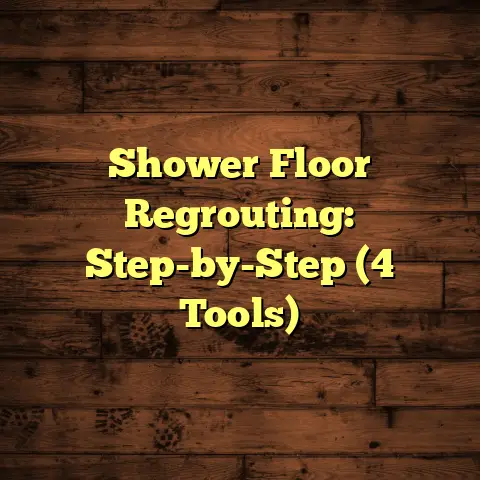Painted Concrete Floors: Ideas? (1 Coat Can Ruin It!)
The innovations in flooring these days are mind-blowing! We’re talking about materials that are more durable, more eco-friendly, and more stylish than ever before.
One trend that’s really taken off is painted concrete floors. They’re a fantastic way to add a unique touch to your home without breaking the bank. Plus, they’re incredibly versatile.
But here’s the thing: painting concrete isn’t as simple as slapping on a coat of paint and calling it a day. Trust me, I’ve seen enough DIY disasters to fill a whole house!
And the biggest mistake I see? Skimping on the paint and thinking one coat is enough. That, my friends, can ruin your entire project. So, let’s dive into the world of painted concrete floors and learn how to do it right!
Section 1: The Rise of Painted Concrete Floors
Concrete has been around for centuries, used in everything from ancient Roman structures to modern skyscrapers. But it’s only relatively recently that we’ve started seeing it as a viable interior flooring option.
Why the change? Well, for starters, concrete is incredibly durable and long-lasting. It can withstand heavy foot traffic, kids playing, and even the occasional spilled glass of wine.
Plus, it’s a sustainable choice. Concrete is made from readily available materials, and it can even be recycled. And with the rise of minimalist and industrial-chic design styles, concrete’s raw, natural look has become incredibly appealing.
But let’s be honest, plain concrete can be a bit… well, plain. That’s where painting comes in! Painting concrete allows you to customize the look of your floors to perfectly match your style. You can go for a sleek, modern look with a glossy finish, or create a rustic, farmhouse vibe with a matte texture.
The possibilities are endless!
Did you know? The global concrete flooring market is expected to reach $52.7 billion by 2027, according to a report by Allied Market Research. That shows you how popular this flooring option has become! Allied Market Research
Section 2: The Art of Painting Concrete Floors
Okay, so you’re ready to transform your concrete floors with a fresh coat of paint. Awesome! But before you grab a brush, there are a few things you need to know.
1. Surface Preparation is Key:
This is the most crucial step! You can’t just paint over a dirty, cracked surface and expect it to look good. You need to start with a clean, smooth, and properly prepared surface.
- Cleaning: Start by thoroughly cleaning the concrete floor.
Remove any dirt, dust, grease, or debris. I recommend using
a concrete cleaner and a stiff brush. You might even need to
use a pressure washer for stubborn stains. - Repairing Cracks: If your concrete has any cracks or
holes, you’ll need to repair them before painting. Use a
concrete patch or repair compound to fill in the cracks,
and then smooth it out with a trowel. - Etching: This step is essential for ensuring proper paint
adhesion. Etching opens up the pores of the concrete,
allowing the primer and paint to grip better. You can use
a chemical etcher or a mechanical grinder for this step.
2. Primer Selection:
Primer is like the foundation of your painted floor. It helps the paint adhere properly, seals the concrete, and prevents moisture from seeping through.
- Acrylic Primers: These are a good all-around choice
for most concrete floors. They’re easy to apply, affordable,
and provide good adhesion. - Epoxy Primers: If you’re dealing with a high-traffic area
or a floor that’s exposed to moisture, an epoxy primer is
the way to go. They’re more durable and provide better
protection against wear and tear.
3. Paint Types:
Choosing the right paint is just as important as choosing the right primer.
- Acrylic Latex Paints: These are water-based paints that
are easy to apply and clean up. They’re a good choice for
low-traffic areas like bedrooms or living rooms. - Epoxy Paints: Epoxy paints are incredibly durable and
resistant to chemicals, stains, and abrasion. They’re ideal
for high-traffic areas like garages, basements, or kitchens. - Urethane Paints: Urethane paints offer excellent UV
resistance, making them a good choice for outdoor concrete
floors or areas that get a lot of sunlight.
4. Application Techniques:
Even with the best materials, poor application can lead to disastrous results.
- Rolling: Use a high-quality roller with a nap that’s
appropriate for the texture of your concrete. Apply the
paint in thin, even coats, overlapping each stroke slightly. - Brushing: Use a brush for cutting in along the edges of
the room or for painting intricate details. - Spraying: If you’re painting a large area, a sprayer can
save you a lot of time and effort. However, it requires
more skill and preparation to avoid overspray and uneven coverage.
Pro Tip: Always follow the manufacturer’s instructions for drying times and recoating intervals. Rushing the process can lead to peeling, cracking, or other problems.
Section 3: The One-Coat Dilemma
Alright, let’s get to the heart of the matter: why one coat of paint is almost never enough.
Think of it this way: concrete is a porous material. It’s like a sponge, soaking up everything it comes into contact with. When you apply just one coat of paint, it’s like trying to fill that sponge with a single drop of water. It’s just not going to work!
Here’s what can happen when you skimp on the paint:
- Peeling: The paint won’t adhere properly to the concrete,
and it will start to peel off in sheets. - Fading: The color will fade quickly, especially in areas
that get a lot of sunlight. - Uneven Texture: The concrete will show through the paint,
creating an uneven and blotchy appearance. - Lack of Durability: The paint won’t be able to withstand
wear and tear, and it will scratch and chip easily.
I had a client once who tried to save money by only applying one coat of paint to their garage floor. Within a few months, the paint started peeling, and the floor looked like a disaster. They ended up having to hire me to redo the entire floor, which cost them way more than if they had just done it right the first time!
Here’s a table illustrating the potential consequences of applying only one coat of paint:
| Issue | Description |
|---|---|
| Poor Adhesion | Paint doesn’t bond well, leading to peeling and chipping. |
| Uneven Coverage | Results in a patchy and inconsistent appearance. |
| Reduced Durability | Floor is more susceptible to scratches, stains, and wear. |
| Color Fading | Pigments break down faster, causing the color to lose vibrancy. |
| Moisture Damage | Without adequate protection, moisture can penetrate and damage the concrete. |
The Solution:
Always apply at least two coats of paint, and sometimes even three, depending on the type of paint and the condition of your concrete. Each coat builds on the previous one, creating a strong, durable, and beautiful finish.
Section 4: Creative Ideas for Painted Concrete Floors
Now for the fun part! Once you’ve got the basics down, you can start exploring the endless design possibilities of painted concrete floors.
- Geometric Patterns: Create a modern and eye-catching
look with geometric patterns like stripes, chevrons, or
triangles. Use painter’s tape to create clean lines and
experiment with different color combinations. - Color Blocking: Divide your floor into different sections
and paint each section a different color. This is a great
way to add visual interest and define different areas of
a room. - Faux Finishes: Get the look of expensive materials like
marble or wood without the hefty price tag. Use special
painting techniques and glazes to create realistic faux
finishes on your concrete floors. - Stenciling: Add intricate designs and patterns to your
floors with stencils. You can find a wide variety of stencils
online or at your local craft store. - Seasonal Themes: Change up your floors with seasonal
themes or motifs. Paint pumpkins and leaves for fall, snowflakes
for winter, or flowers for spring.
Here are a few examples to get your creative juices flowing:
- Modern Minimalist: A sleek, gray concrete floor with a
glossy finish. - Rustic Farmhouse: A warm, beige concrete floor with a
matte texture and a stenciled floral border. - Bohemian Chic: A colorful concrete floor with a geometric
pattern and a distressed finish.
Don’t be afraid to experiment and let your personality shine through!
Section 5: Maintenance and Longevity of Painted Concrete Floors
So, you’ve got your beautiful, newly painted concrete floors. Now, how do you keep them looking their best for years to come?
- Regular Cleaning: Sweep or vacuum your floors regularly
to remove dirt and debris. Mop with a mild detergent and
water as needed. - Avoid Harsh Chemicals: Don’t use harsh chemicals or
abrasive cleaners, as they can damage the paint. - Use Floor Mats: Place floor mats at entrances to trap dirt
and prevent it from being tracked onto your floors. - Protect Against Scratches: Use furniture pads under
furniture legs to prevent scratches. - Reseal Regularly: Consider resealing your floors every
few years to protect the paint and maintain its luster.
Environmental Factors:
- Moisture: Excessive moisture can cause the paint to peel
or blister. Make sure your concrete is properly sealed and
that you address any moisture issues in your home. - Sunlight: Prolonged exposure to sunlight can cause the
paint to fade. Use UV-resistant paints and consider using
window coverings to protect your floors.
According to the National Association of Realtors, well- maintained flooring can increase a home’s value by up to 10%. So, taking care of your painted concrete floors is not only about aesthetics, it’s also a smart investment!
Section 6: Common Mistakes to Avoid
Okay, we’ve talked about the one-coat dilemma, but there are other common mistakes that homeowners make when painting concrete floors. Let’s take a look:
- Poor Surface Preparation: We’ve already emphasized this,
but it’s worth repeating. Skimping on surface prep is a recipe
for disaster. - Incorrect Paint Selection: Using the wrong type of paint
can lead to peeling, fading, and other problems. Make sure
you choose a paint that’s specifically designed for concrete floors. - Failure to Test for Moisture: Concrete can absorb moisture
from the ground, which can cause the paint to fail. Before
painting, test your concrete for moisture using a moisture meter. - Ignoring Temperature and Humidity: Temperature and
humidity can affect the drying time and adhesion of the paint.
Follow the manufacturer’s instructions for optimal conditions. - Rushing the Process: Don’t rush the painting process.
Allow each coat of primer and paint to dry completely before
applying the next one.
What to do if you make a mistake:
- Peeling Paint: Scrape off the loose paint, sand the surface,
and reapply primer and paint. - Uneven Coverage: Apply another coat of paint to even out
the coverage. - Cracking Paint: Fill in the cracks with a concrete patch,
sand the surface, and reapply primer and paint.
Remember: Planning and research are key to a successful painted concrete floor project. Take the time to do your homework and avoid these common mistakes.
Section 7: Expert Insights and Testimonials
I’m not the only one who’s passionate about painted concrete floors! I’ve talked to other experts and homeowners who have had great experiences with this flooring option.
Quote from [Flooring Expert Name], a concrete flooring specialist:
“Painted concrete floors are a fantastic way to add a unique
touch to any space. But it’s crucial to invest in quality
materials and proper preparation. Don’t cut corners, and
always follow the manufacturer’s instructions.”
Testimonial from [Homeowner Name], who recently painted their basement floor:
“I was hesitant to try painting my concrete basement floor,
but I’m so glad I did! It completely transformed the space.
I followed all the instructions carefully, and I’m thrilled
with the results. It’s durable, easy to clean, and looks amazing!”
Another quote from [Interior Designer Name]:
“As a designer, I love using painted concrete floors because
they offer so much versatility. You can create any look you
want, from modern and minimalist to rustic and eclectic.
And they’re a great way to add a pop of color or pattern to
a room.”
These are just a few examples of the positive experiences people have had with painted concrete floors. With proper planning and execution, you can achieve stunning results and transform your space.
Conclusion
So, there you have it! Painted concrete floors are a stylish, customizable, and practical flooring choice that can add value and beauty to your home.
But remember, proper preparation, application, and maintenance are essential to avoid common pitfalls, particularly the critical mistake of applying just one coat of paint.
Take the time to do your research, choose the right materials, and follow the instructions carefully. And don’t be afraid to get creative and let your personality shine through!
I hope this article has inspired you to consider painted concrete floors for your next home improvement project. Good luck, and happy painting!





